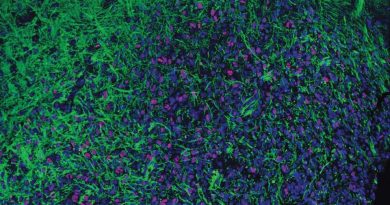Patients With Post-COVID Cognitive Symptoms May Have Gliosis
Editor’s note: Find the latest long COVID news and guidance in Medscape’s Long COVID Resource Center.
Patients with persistent depressive or cognitive symptoms after mild to moderate COVID-19 (COVID-DC) may have gliosis and inflammation, data suggest.
In a case-control study of 40 patients who were treated at a tertiary care psychiatric hospital in Canada, the level of translocator protein total distribution volume (TSPO VT), a marker of gliosis, was 9.23 mL/cm3 among patients with COVID-DC and 7.72 mL/cm3 among control persons. Differences were particularly notable in the ventral striatum and dorsal putamen.

Dr Jeffrey Meyer
“Most theories assume there is inflammation in the brain [with] long COVID,” but that assumption had not been studied, author Jeffrey H. Meyer, MD, PhD, Canada Research Chair in Neurochemistry of Major Depressive Disorder at the University of Toronto, told Medscape Medical News. “Such information is pivotal to developing treatments.”
The study was published online May 31 in JAMA Psychiatry.
Quantifiable Marker
The investigators sought to determine whether levels of TSPO VT, which are quantifiable with PET, are elevated in the dorsal putamen, ventral striatum, prefrontal cortex, anterior cingulate cortex, and hippocampus of patients with COVID-DC, compared with patients without this syndrome. These brain regions were chosen, according to the authors, “because injury in these regions, which can cause gliosis, also induces symptoms of COVID-DC.”
The study was conducted from April 2021 through June 30, 2022. The investigators compared levels of TSPO VT in the selected brain regions of 20 participants with COVID-DC (mean age, 32.7 years; 60% women) with that of 20 control persons (mean age, 33.3 years; 55% women). TSPO VT was measured with fluorine F18–labeled N-(2-(2-fluoroethoxy)benzyl)-N-(4-phenoxypyridin-3-yl)acetamide PET.
The difference in TSPO VT was most noticeable in the ventral striatum (mean difference, 1.97 mL/cm3) and dorsal putamen (mean difference, 1.70 mL/cm3). The study authors suggest that gliosis in these areas may explain some of the persistent symptoms reported in structured clinical interviews and assessed on neuropsychological and psychological testing.
For patients with COVID-DC, motor speed on the finger-tapping test was negatively associated with dorsal putamen TSPO VT (r, −0.53). The 10 participants with COVID-DC whose speed was lowest had higher mean dorsal putamen TSPO VT levels than control persons by 2.3 mL/cm3.
The investigators could not assess a possible association between the ventral striatum TSPO VT and anhedonia because all participants had these symptoms. No significant correlations were found between depression and TSPO VT in the prefrontal cortex or anterior cingulate cortex.
The authors acknowledge that the study was cross-sectional, and so the duration of persistently elevated TSPO VT is not yet known. In addition, elevation in TSPO VT is not completely specific to glial cells, and although correlations with finger-tapping test performance reflect associations between brain changes and symptoms, they do not prove cause and effect.
“Presently, clinicians can use treatments for symptoms in other illnesses that are [also] common with long COVID. We need better than this,” said Meyer. “Clients with long COVID should be able to state their symptoms, and the practitioner should have an evidence-based matching treatment to recommend.”
Research is ongoing. “We are acquiring more information regarding different types of inflammation in the brain, whether there is ongoing injury, and whether treatments that influence inflammation are helpful,” said Meyer.
Jigsaw Puzzle
“While this is an important piece in the jigsaw puzzle of neuroinflammation in chronic neurological disease, it is important to keep in mind that we still lack understanding of the complex picture for several reasons,” wrote Alexander Gerhard, MD, honorary senior lecturer in neuroscience at the University of Manchester, United Kingdom, in an accompanying editorial.
Among these reasons is that the PET technique used in the study is noisy and not restricted to glial cells, he wrote. TSPO expression is only one part of the brain’s neuroinflammatory response, but PET techniques “do not currently allow us to distinguish between different states of microglial activation.” In addition, “a much more detailed understanding of microglial activation at different time points” is needed before neuroinflammatory changes can be targeted therapeutically, Gerhard wrote.

Dr Vilma Gabbay
Commenting on the study for Medscape, Vilma Gabbay, MD, director of research at the Psychiatry Research Institute of Montefiore and Einstein in New York and associate professor of psychiatry and neuroscience, said, “This is an important initial step to better understand the neuropsychiatric consequences of COVID even in only a mild and moderate viral illness.” TSPO imaging through PET scanning has been used as an index for neuroinflammation and gliosis. Researchers have used it to study neurodegenerative diseases, but as the authors note, the ligand is not specific for gliosis.
“Follow-up large cohort studies including other measures of neuroimaging modalities assessing circuitry and neurochemistry are needed,” she said. “Similarly, studying the blood-brain barrier will also allow us to better understand how the immune reaction in the blood transitions to the brain.”
This field of research is evolving, and clinical trials are ongoing, Gabbay added. Meanwhile, clinicians should monitor for, assess, and treat neuropsychiatric symptoms and “follow the literature for new research and management recommendations.”
The study was primarily funded by a Canadian Institutes of Health Research Project grant to the authors, with some funding from the Canadian Institute for Military and Veteran Health Research. Meyer received support from their Canada Research Chair awards and received grants and support from several pharmaceutical companies outside of the submitted work. Gerhard and Gabbay disclosed no relevant financial relationships.
JAMA Psychiatry. Published online May 31, 2023. Full text
Follow Marilynn Larkin on Twitter: @MarilynnL.
For more news, follow Medscape on Facebook, Twitter, Instagram, and YouTube.
Source: Read Full Article



